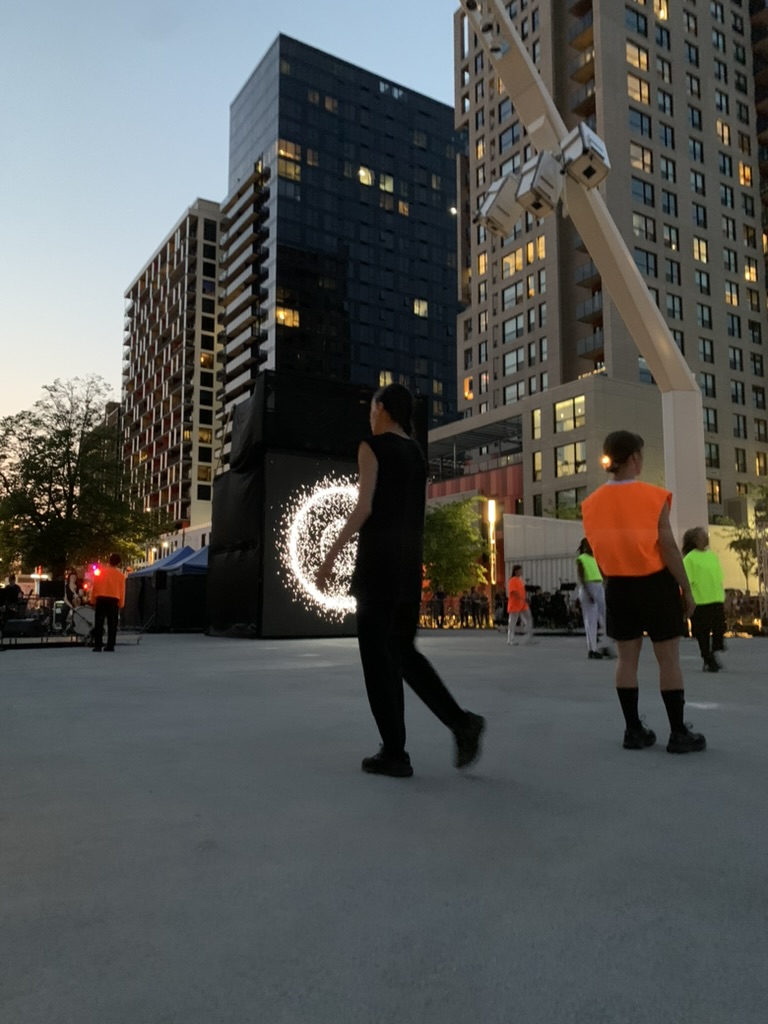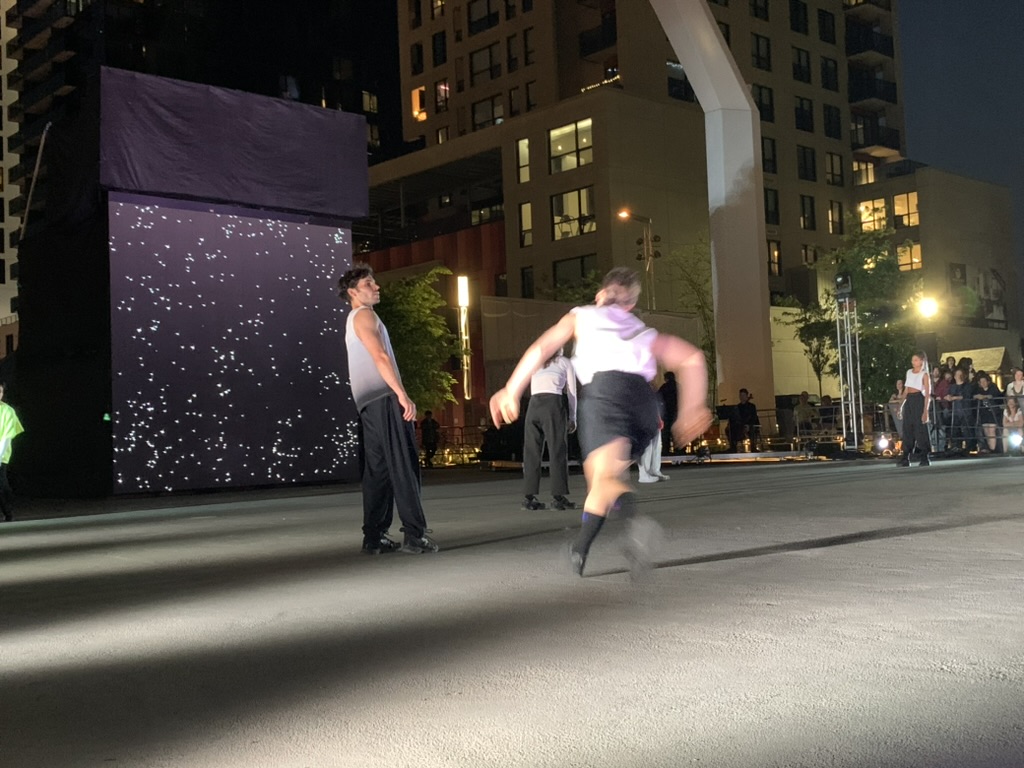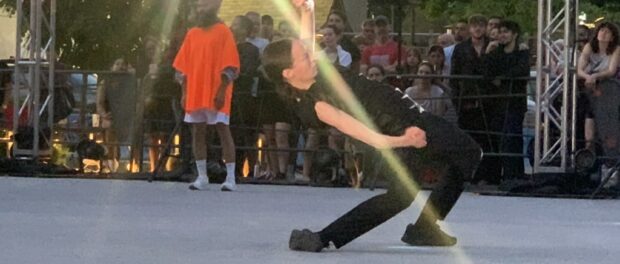Creation Destruction Goes Big
Dana Gingras’ Creation Destruction, performed on the hard cement of the Esplanade Tranquille at dusk, is a piece of great magnitude. While many works deal with the human or humanity, this work touched offers an interpretation of the cosmic, if not divine forces that give rise to all and that eliminate all.

The work begins with 10 dazed dancers dressed in black and neon green and safety orange who slowly spin around in place, forming a horseshoe shape around a central dancer who wears all black. With her long braid whipping about, this central dancer gestures like a magician calling the most minute substances and forces into being. She contorts her body as if dodging bullets in the matrix, stands on the sides of her feet, and sweeps her arms as she shapes air around her. Behind her, a black panel twinkles with lights and ambient orchestral music barely make me think of primordial soup, the big bang, or perhaps more specifically God at work creating the universe.

The screen behind turns into a large spinning orb of light as the dancers begin to walk in circles, their pace getting faster, as if planets orbiting around the sun. From small, individuals, groups of two and three start to move as a unit, breaking the rhythm. It is as if order is coming out of chaos, or I am simply seeing order in chaos. I think of how fractals form, or of how birds fly by paying attention only to those closest to them. Their speed increases as do the complexity of their movements. Meanwhile, the dancer in black, God perhaps, orbits the group by making a slow circle around the entire stage.
The second piece is a variation of the first, although here complexity takes on the form of beings, to judge from the way the dancers would snap at one another. They form warlike gestures as if hunting, or even engaged in meaningless work gestures, while a human head on the screen behind melts into a demonic face and eventually melts away into the randomness of lights, before reforming. The dancers strip away their neon clothes until they are all wearing black and white. In this piece they make formations as a group, and eventually stretch as a long diagonal line across the stage with the dancer in black weaving in and out among them. Finally, the group splits and they seem to torturously die in different places. Destruction.
The third movement knits together the first two and suffice to say it has a magnificent ending that combines both creation and destruction together.

At first, I didn’t trust Creation Destruction, and wondered if I’d set myself up to watch an hour of difficult art that is best understood, if ever, only after reading interviews with the choreographer. But, I was delighted that this piece lit my mind up with ideas and concepts about the formation of all things. I thought of quantum physics and alchemy and schools of fish and lions on the savannah and birds in flight and the Matrix and nuclear war and Japanese films. When a piece can touch the mind with so many as the dancers became more animated my mind began to light up with possibilities as to what I was seeing, I know I am watching something extraordinary. Further, I was moved by their individual fates. Every dancer had an identity to me — if only because the work let them be individuals in the group. One used moves of breakdance, another had long white braids that snapped in the air, another was bonelessly flexible, one’s expression emanated pathos. Even “God” had a personality as she shaped and observed and destroyed.

Of course, two things that also contributed to this rather epic piece – the music and the pixelated board. Gingras invited four members of Godspeed You! Black Emperor to create the music. This post-rock, anarchist group long beloved in Montreal produces experiential music with long trajectories. Orchestral, ambient, massive crescendos, and walls of sound — it is the music that one could imagine God making a universe to. The pixelated board by London-based United Visual Artists is nothing short of what one would expect from this accomplished art collective that works on pieces for concerts, public art installations, and performance. Their work is not a mere accidental backdrop but an active part of the works to which they contribute.

Finally, before the show, Lara Kramer performed an offering invitation. It wasn’t obvious when it started, but I noticed that a woman wrapped herself in a striking grey blanket covered with golden bells and a red zig zag and tried to get comfortable on and around a bench. The bells tinkled as she lay down, got up, tried another position. Another woman and her child were chosen from the audience to witness the work. Kramer is of Oji-cree and settler heritage and placing her work at the start of the piece was almost like a land acknowledgement or perhaps more of a land reprimand. Brief, but powerful, Kramer’s work suggested that the space of the performance, all space really, has been taken from others and transformed in such a way that the original inhabitants have been made unwelcome.
Kudos to the Festival TransAmériques for offering up Creation Destruction, a powerful and evocative work that embeds the most epic of themes within.
The Festival TransAmériques (FTA) continues in Montreal until June 8. Information about shows and tickets can be found HERE.






